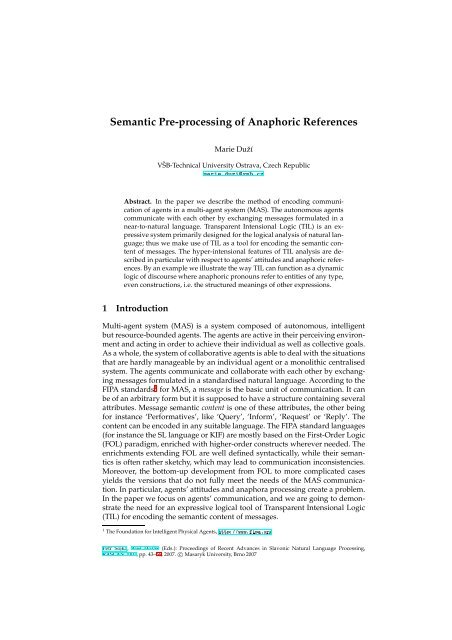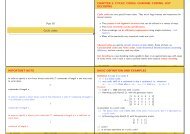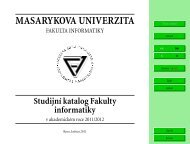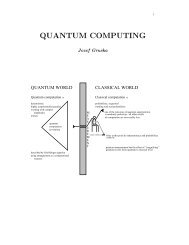Semantic Pre-processing of Anaphoric References
Semantic Pre-processing of Anaphoric References
Semantic Pre-processing of Anaphoric References
Create successful ePaper yourself
Turn your PDF publications into a flip-book with our unique Google optimized e-Paper software.
ÑÖºÙÞÚ׺Þ<br />
<strong>Semantic</strong> <strong>Pre</strong>-<strong>processing</strong> <strong>of</strong> <strong>Anaphoric</strong> <strong>References</strong><br />
Marie Duží<br />
VŠB-Technical University Ostrava, Czech Republic<br />
Abstract. In the paper we describe the method <strong>of</strong> encoding communication<br />
<strong>of</strong> agents in a multi-agent system (MAS). The autonomous agents<br />
communicate with each other by exchanging messages formulated in a<br />
near-to-natural language. Transparent Intensional Logic (TIL) is an expressive<br />
system primarily designed for the logical analysis <strong>of</strong> natural language;<br />
thus we make use <strong>of</strong> TIL as a tool for encoding the semantic content<br />
<strong>of</strong> messages. The hyper-intensional features <strong>of</strong> TIL analysis are described<br />
in particular with respect to agents’ attitudes and anaphoric references.<br />
By an example we illustrate the way TIL can function as a dynamic<br />
logic <strong>of</strong> discourse where anaphoric pronouns refer to entities <strong>of</strong> any type,<br />
even constructions, i.e. the structured meanings <strong>of</strong> other expressions.<br />
1 Introduction<br />
Multi-agent system (MAS) is a system composed <strong>of</strong> autonomous, intelligent<br />
but resource-bounded agents. The agents are active in their perceiving environment<br />
and acting in order to achieve their individual as well as collective goals.<br />
As a whole, the system <strong>of</strong> collaborative agents is able to deal with the situations<br />
that are hardly manageable by an individual agent or a monolithic centralised<br />
system. The agents communicate and collaborate with each other by exchanging<br />
messages formulated in a standardised natural language. According to the<br />
FIPA standards 1 for MAS, a message is the basic unit <strong>of</strong> communication. It can<br />
be <strong>of</strong> an arbitrary form but it is supposed to have a structure containing several<br />
attributes. Message semantic content is one <strong>of</strong> these attributes, the other being<br />
for instance ‘Performatives’, like ‘Query’, ‘Inform’, ‘Request’ or ‘Reply’. The<br />
content can be encoded in any suitable language. The FIPA standard languages<br />
(for instance the SL language or KIF) are mostly based on the First-Order Logic<br />
(FOL) paradigm, enriched with higher-order constructs wherever needed. The<br />
enrichments extending FOL are well defined syntactically, while their semantics<br />
is <strong>of</strong>ten rather sketchy, which may lead to communication inconsistencies.<br />
Moreover, the bottom-up development from FOL to more complicated cases<br />
yields the versions that do not fully meet the needs <strong>of</strong> the MAS communication.<br />
In particular, agents’ attitudes and anaphora <strong>processing</strong> create a problem.<br />
In the paper we focus on agents’ communication, and we are going to demonstrate<br />
the need for an expressive logical tool <strong>of</strong> Transparent Intensional Logic<br />
(TIL) for encoding the semantic content <strong>of</strong> messages.<br />
1 The Foundation for Intelligent Physical Agents,ØØÔ»»ÛÛÛºÔºÓÖ<br />
Petr Sojka, Aleš Horák (Eds.): Proceedings <strong>of</strong> Recent Advances in Slavonic Natural Language Processing,<br />
RASLAN 2007, pp. 43–56, 2007. c○ Masaryk University, Brno 2007
44 Marie Duží<br />
The paper is organised as follows. After briefly introducing TIL philosophy<br />
and motivations in the next Section 2, in Section 3 we describe the method<br />
<strong>of</strong> analysing sentences with anaphoric references occurring in any context;<br />
extensional, intensional, or even hyperintensional context <strong>of</strong> attitudes. By way<br />
<strong>of</strong> an example we demonstrate in Section 4 how TIL functions as the logic <strong>of</strong><br />
dynamic discourse. Finally, a few notes on TIL implementation by the TIL-<br />
Script language are contained in concluding Section 5.<br />
2 Basic notions <strong>of</strong> Transparent Intensional Logic<br />
TIL constructions are uniquely assigned to expressions as their structured meanings.<br />
Intuitively, construction is a procedure (an instruction or a generalised<br />
algorithm), that consists <strong>of</strong> particular sub-instructions on how to proceed in order<br />
to obtain the output entity given some input entities. Thus the sense <strong>of</strong> a<br />
sentence is a hyper-proposition, i.e., the construction <strong>of</strong> a proposition denoted<br />
by the sentence. The denoted proposition is a flat mapping with the domain<br />
<strong>of</strong> possible worlds. Our motive for working ‘top-down’ has to do with anticontextualism:<br />
any given term or expression (even one involving indexicals or<br />
anaphoric pronouns) expresses the same construction as its sense (meaning) in<br />
whatever sort <strong>of</strong> context the term or expression is embedded within. And the<br />
meaning <strong>of</strong> an expression determines the respective denoted entity (if any), but<br />
not vice versa. However, some terms, like those with indexicals or anaphoric<br />
pronouns, express only incomplete meanings (open constructions) and, therefore,<br />
only v(aluation)-denote, being ins<strong>of</strong>ar sensitive to which context they are<br />
embedded in.<br />
There are two kinds <strong>of</strong> constructions, atomic and compound. Atomic constructions<br />
(Variables and Trivializations) do not contain any other constituent but<br />
itself; they supply objects (<strong>of</strong> any type) on which compound constructions operate.<br />
Variables x, y, p, q, . . . , construct objects dependently on a valuation; they<br />
v−construct. Trivialisation <strong>of</strong> an object X(<strong>of</strong> any type, even a construction), in<br />
symbols 0 X, constructs simply Xwithout the mediation <strong>of</strong> any other construction.<br />
Compound constructions, which consist <strong>of</strong> other constituents, are Composition<br />
and Closure. Composition [F A 1 . . . A n ] is the instruction to apply a function<br />
f (v−constructed by F) to an argument A (v−constructed by A 1 . . . A n ). 2 Thus<br />
it v−constructs the value <strong>of</strong> f at A, if the function f is defined at A, otherwise<br />
the Composition is v−improper, i.e., it does not v−construct anything. Closure<br />
[λx 1 . . . x n X] is the instruction to v−construct a function by abstracting over<br />
variables x 1 ,. . . ,x n in the ordinary manner <strong>of</strong> λ-calculi. Finally, higher-order<br />
constructions can be used twice over as constituents <strong>of</strong> composed constructions.<br />
This is achieved by a fifth construction called Double Execution, 2 X, that<br />
behaves as follows: If X v−constructs a construction X’, and X ′ v−constructs<br />
an entity Y, then 2 X v−constructs Y; otherwise 2 X is v−improper.<br />
TIL constructions, as well as the entities they construct, all receive a type.<br />
The formal ontology <strong>of</strong> TIL is bi-dimensional; one dimension is made up <strong>of</strong><br />
2 We treat functions as mappings, i.e., set-theoretical objects, unlike the constructions <strong>of</strong> functions.
<strong>Semantic</strong> <strong>Pre</strong>-<strong>processing</strong> <strong>of</strong> <strong>Anaphoric</strong> <strong>References</strong> 45<br />
constructions, the other dimension encompasses non-constructions. On the<br />
ground level <strong>of</strong> the type-hierarchy, there are entities unstructured from the<br />
algorithmic point <strong>of</strong> view belonging to a type <strong>of</strong> order 1. Given a so-called<br />
epistemic (or ‘objectual’) base <strong>of</strong> atomic types (o-truth values, ι-individuals,<br />
τ-time moments / real numbers, ω-possible worlds), the induction rule for<br />
forming functions is applied: where α, β 1 ,. . . ,β n are types <strong>of</strong> order 1, the set <strong>of</strong><br />
partial mappings from β 1 ×. . . ×β n to α, denoted (α β 1 . . . β n ), is a type <strong>of</strong> order<br />
1 as well. 3 Constructions that construct entities <strong>of</strong> order 1 are constructions <strong>of</strong><br />
order 1. They belong to a type <strong>of</strong> order 2, denoted by * 1 . This type * 1 together<br />
with atomic types <strong>of</strong> order 1 serves as a base for the induction rule: any<br />
collection <strong>of</strong> partial mappings, type (α β 1 . . . β n ), involving * 1 in their domain<br />
or range is a type <strong>of</strong> order 2. Constructions belonging to a type * 2 that identify<br />
entities <strong>of</strong> order 1 or 2, and partial mappings involving such constructions,<br />
belong to a type <strong>of</strong> order 3. And so on ad infinitum.<br />
An object A <strong>of</strong> a type α is called an α-object, denoted A/α. That a construction<br />
C v−constructs an α-object is denoted C → v α. Quantifiers, ∀ α (the general<br />
one) and ∃ α (the existential one), are <strong>of</strong> types (o(oα)), i.e., sets <strong>of</strong> sets <strong>of</strong><br />
α-objects. 4 [ 0 ∀ α λxA] v−constructs True iff [λxA] v−constructs the whole type<br />
α, otherwise False; [ 0 ∃ α λxA] v−constructs True iff [λxA] v−constructs a nonempty<br />
subset <strong>of</strong> the type α, otherwise False. We write ‘∀xA’, ‘∃xA’ instead <strong>of</strong><br />
‘[ 0 ∀ α λxA]’, ‘[ 0 ∃ α λxA]’, respectively, when no confusion can arise. Singularisers<br />
ι α are <strong>of</strong> types (α(oα)); [ 0 ι α λxA] v−constructs the only α-member <strong>of</strong> the singleton<br />
v−constructed by λxA, otherwise (i.e., if λxA v-constructs an empty class<br />
or a multi-element class) v−improper.<br />
We use an infix notation without trivialisation when using constructions<br />
<strong>of</strong> truth-value functions ∧ (conjunction), ∨ (disjunction), ⊃ (implication), ≡<br />
(equivalence) and negation (¬), and when using a construction <strong>of</strong> an identity.<br />
(α-)intensions are members <strong>of</strong> a type (αω), i.e., functions from possible<br />
worlds to an arbitrary type α. (α-)extensions are members <strong>of</strong> the type α, where<br />
α is not equal to (βω) for any β, i.e., extensions are not functions from<br />
possible worlds. Intensions are frequently functions <strong>of</strong> a type ((ατ)ω), i.e.,<br />
functions from possible worlds to chronologies <strong>of</strong> the type α (in symbols: α τω ),<br />
where a chronology is a function <strong>of</strong> type (ατ). We will use variables w, w 1 ,<br />
. . . as v−constructing elements <strong>of</strong> type ω (possible worlds), and t, t 1 , . . . as<br />
v−constructing elements <strong>of</strong> type τ (times). If C → α τω v−constructs an α-<br />
intension, the frequently used Composition <strong>of</strong> the form [[Cw]t], the intensional<br />
descent <strong>of</strong> the α-intension, is abbreviated as C wt .<br />
Some important kinds <strong>of</strong> intensions are:<br />
Propositions, type o τω . They are denoted by empirical (declarative) sentences.<br />
3 TIL is an open-ended system. The above epistemic base {o, ι, τ, ω} was chosen, because it is apt for<br />
natural-language analysis, but the choice <strong>of</strong> base depends on the area to be analysed. 4 Collections, sets,<br />
classes <strong>of</strong> ‘α-objects’ are members <strong>of</strong> type (oα); TIL handles classes (subsets <strong>of</strong> a type) as characteristic functions.<br />
Similarly relations (-in-extension) are <strong>of</strong> type(s) (oβ 1 . . . β m ).
46 Marie Duží<br />
Properties <strong>of</strong> members <strong>of</strong> a type α, or simply α-properties, type (oα) τω . General<br />
terms (some substantives, intransitive verbs) denote properties, mostly <strong>of</strong><br />
individuals.<br />
Relations-in-intension, type (oβ 1 . . . β m ) τω . For example transitive empirical<br />
verbs, also attitudinal verbs denote these relations.<br />
α-roles, <strong>of</strong>fices, type α τω , where α ̸= (oβ). Frequently ι τω . Often denoted by<br />
concatenation <strong>of</strong> a superlative and a noun (“the highest mountain”).<br />
Example: We are going to analyse the sentence “Adam is looking for a<br />
parking place”. Our method <strong>of</strong> analysis consists <strong>of</strong> three steps:<br />
1. Type-theoretical analysis, i.e., assigning types to the objects talked about by<br />
the analysed sentence. In our case we have:<br />
(a) Adam/ι;<br />
(b) Look_for/(oι(oι) τω ) τω −the relation-in-intension <strong>of</strong> an individual to a<br />
property <strong>of</strong> individuals: the seeker wants to find an instance <strong>of</strong> the<br />
property;<br />
(c) Parking(Place)/(oι) τω −the property <strong>of</strong> individuals.<br />
2. Synthesis, i.e., composing the constructions <strong>of</strong> the objects ad (1) in order<br />
to construct the proposition <strong>of</strong> type o τω denoted by the whole sentence.<br />
The sentence claims that the individual Adam has the ‘seeking-property’<br />
<strong>of</strong> looking for a parking place. Thus we have to construct the individual<br />
Adam, the ‘seeking-property’, and then apply the latter to the former. Here<br />
is how:<br />
(a) The atomic construction <strong>of</strong> the individual called Adam is simply 0 Adam;<br />
(b) The ‘seeking-property’ has to be constructed by Composing the<br />
relation-in-intension Look_for with a seeker x → ι and the<br />
property Parking/(oι) τω an instance <strong>of</strong> which is being sought:<br />
[ 0 Look_for wt x 0 Parking] v−constructing a truth value. Abstracting first<br />
from x by λx[ 0 Look_for wt x 0 Parking] we obtain the class <strong>of</strong> individuals;<br />
abstracting further from wandt we obtain the ‘seeking-property’:<br />
λwλt [λx[ 0 Look_for wt x 0 Parking]].<br />
(c) Now we have to Compose the property constructed ad (b) with the<br />
individual constructed ad (a). The property has to be subjected to the<br />
intensional descent first, i.e., [λwλt [λx[ 0 Look_for wt x 0 Parking]]] wt and<br />
then Composed with the former. 5 Since we are going to construct a<br />
proposition, i.e., an intension, we finally have to abstract from w, t:<br />
λwλt [[λwλt [λx[ 0 Look_for wt x 0 Parking]]] 0 wt Adam].<br />
This construction is the literal analysis <strong>of</strong> our sentence. It can be still<br />
β-reduced to the equivalent form:<br />
λwλt [ 0 Look_for 0 wt Adam 0 Parking].<br />
5 For details on predication <strong>of</strong> properties and relations-in-intension <strong>of</strong> individuals, see Jespersen (forthcoming).
<strong>Semantic</strong> <strong>Pre</strong>-<strong>processing</strong> <strong>of</strong> <strong>Anaphoric</strong> <strong>References</strong> 47<br />
3. Type-Theoretical checking:<br />
λwλt [ 0 Look_for 0 wt<br />
Adam 0 Parking ]<br />
(oι(oι) τω )<br />
}<br />
ι<br />
{{<br />
(oι) τω<br />
}<br />
o<br />
o τω<br />
The role <strong>of</strong> Trivialisation and empirical parameters w → ω, t → τ in the<br />
communication between agents can be elucidated as follows. Each agent has<br />
to be equipped with a basic ontology, namely the set <strong>of</strong> primitive concepts<br />
(Trivialised objects) she is informed about. Thus the upper index ‘ 0 ’ serves as a<br />
marker <strong>of</strong> the primitive concept that the agents should have in their ontology.<br />
If they do not, they have to learn them by asking the others. The lower index<br />
‘ wt ’ can be understood as an instruction to execute an empirical inquiry (search)<br />
in order to obtain the actual current value <strong>of</strong> an intension, for instance by<br />
searching agent’s database or by asking the other agents, or even by means<br />
<strong>of</strong> agent’s sense perception.<br />
3 Anaphora and Meaning<br />
The problem <strong>of</strong> an anaphoric reference to a previously used expression is<br />
a well-known hard nut <strong>of</strong> linguistic analysis, because the antecedent <strong>of</strong> the<br />
anaphoric reference is <strong>of</strong>ten not unambiguously determined. Thus it is <strong>of</strong>ten<br />
said that anaphora constitutes a pragmatic problem rather than a problem<br />
<strong>of</strong> logical semantics. We agree that logical analysis cannot disambiguate any<br />
sentence, because it presupposes understanding and full linguistic competence.<br />
Yet our method <strong>of</strong> logical analysis can contribute to solving the problem <strong>of</strong><br />
disambiguation in at least two respects; (a) a type-theoretical analysis <strong>of</strong>ten<br />
unambiguously determines which <strong>of</strong> the possible meanings <strong>of</strong> a homonymous<br />
expression is used in a sentence, and (b) if there are two or more possible<br />
readings <strong>of</strong> a sentence, the logical analysis should make all <strong>of</strong> them explicit.<br />
This <strong>of</strong>ten concerns the distinction between de dicto and de re readings.<br />
In this section we propose a method <strong>of</strong> logically analysing sentences with<br />
anaphoric references. The method consists in substituting an appropriate<br />
construction <strong>of</strong> the object to which the anaphora refers for the anaphoric<br />
variable. In other words, we perform a semantic pre-<strong>processing</strong> <strong>of</strong> the embedded<br />
anaphoric clause based on the meaning <strong>of</strong> the respective antecedent. In this<br />
sense anaphora is a semantic problem.<br />
3.1 <strong>Semantic</strong> pre-<strong>processing</strong> <strong>of</strong> <strong>Anaphoric</strong> <strong>References</strong><br />
Our hyperintensional (procedural) semantics makes it possible to apply anticontextualist<br />
and compositional analysis to anaphoric sentences. The meaning<br />
<strong>of</strong> a sentence containing a clause with an anaphoric reference is the procedure<br />
which is a two-phase instruction that comes down to this:
48 Marie Duží<br />
(i) execute the substitution based on the meaning <strong>of</strong> the antecedent for the anaphoric<br />
variable;<br />
(ii) execute the result (a propositional construction) again to obtain a proposition.<br />
To specify phase (i) we make use <strong>of</strong> the fact that constructions are objects<br />
sui generis that the other constructions can operate on. The substitution is<br />
realised by a function Sub/(* n * n * n * n ) that operates on constructions C 1 , C 2<br />
and C 3 yielding as output the construction C 4 that is the result <strong>of</strong> substituting<br />
C 1 for C 2 in C 3 . The phase (ii) consists in executing the adjusted meaning,<br />
namely the construction pre-processed by phase (i). To this end we use the<br />
fifth construction defined above, the Double Execution. The method is uniquely<br />
applicable to all kinds <strong>of</strong> sentences, including those that express (de dicto / de<br />
re) attitudes to a hyperintension, attitudes to an intension, and relations (-inintension)<br />
to extensional entities. Now we adduce examples that illustrate the<br />
method. (A) “5 + 7 = 12, and Charles knows it.”<br />
The embedded clause “Charles knows it” does not express Charles’<br />
relation(-in-intension) to a truth-value, but to a construction, here the procedure<br />
<strong>of</strong> calculating the result <strong>of</strong> 5 + 7 = 12. Hence Know(ing)/(oι* 1 ) τω is a relation-inintension<br />
<strong>of</strong> an individual to a construction.However, the meaning <strong>of</strong> the clause<br />
is incomplete; it is an open construction with the free variable it: λwλt[ 0 Know wt<br />
0 Charles it]. The variable it/* 2 → ∗ 1 is the meaning <strong>of</strong> the pronoun ‘it’ that in<br />
(A) anaphorically refers to the meaning <strong>of</strong> “5 + 7 = 12”, i.e., the construction<br />
[ 0 + 0 5 0 7]. The meaning <strong>of</strong> the whole sentence (A) is, however, complete. It is<br />
the closed construction<br />
(A’)<br />
λwλt[[ 0 = 0 + 0 5 0 7] 0 12] ∧<br />
z [ 0 Sub 00 [ 0 = 0 + 0 5 0 7] 0 12] 0 it 0 [λwλt[ 0 Know wt 0 Charles it]]] wt ]<br />
Types: Charles/ι; Know/(oι* 1 ) τω ; Sub/(* 2 * 2 * 2 * 2 ); it/* 2 → * 1 ; the other types<br />
are obvious.<br />
Since (A’) seems to be rather complicated, we now show that (A’) is an<br />
adequate analysis meeting our three requirements <strong>of</strong> compositionality, anticontextualism<br />
and a purely semantic solution. The argument <strong>of</strong> the second<br />
conjunct <strong>of</strong> (A’), namely<br />
(S) [ 0 Sub 00 [ 0 = 0 + 0 5 0 7] 0 12] 0 it 0 [λwλt[ 0 Know wt 0 Charles it]]] wt ] → * 1<br />
constructs a construction <strong>of</strong> order 1, namely the one obtained by the substitution<br />
<strong>of</strong> the construction 0 [ 0 = 0 + 0 5 0 7] 0 12] for the variable it into the construction<br />
[λwλt[ 0 Know wt 0 Charles it]].The result is the construction<br />
(S’) [λwλt[ 0 Know wt 0 Charles 0 [ 0 = 0 + 0 5 0 7] 0 12]]],<br />
which constructs a proposition P. But an argument <strong>of</strong> the truth-value function<br />
conjunction (∧) can be neither a propositional construction, nor a proposition,<br />
but must be a truth-value. Since (S) constructs the construction (S’), and (S’)<br />
constructs the proposition P, the execution steps have to be: (a) execute (S) to<br />
obtain the propositional construction (S’), (b) execute the result (S’) to obtain<br />
the proposition P; hence we need the Double Execution <strong>of</strong> (S) to construct the
<strong>Semantic</strong> <strong>Pre</strong>-<strong>processing</strong> <strong>of</strong> <strong>Anaphoric</strong> <strong>References</strong> 49<br />
proposition P, and then (c) P has to undergo intensional descent with respect to<br />
the external w, t in order to v−construct a truth-value.<br />
Note that the open construction λwλt [ 0 Know 0 wtCharles it] is assigned to<br />
“Charles knows it” invariably <strong>of</strong> a context. The variable it is free here either<br />
for a pragmatic valuation or for a substitution by means <strong>of</strong> the meaning <strong>of</strong><br />
the antecedent that is referred to in the linguistic context. The object—what<br />
is known by Charles—can be completed by a situation <strong>of</strong> utterance or by<br />
a linguistic context. If the sentence occurs within another linguistic context,<br />
then Sub substitutes a different construction for the variable it, namely the<br />
construction to which ‘it’ anaphorically refers.<br />
The other example concerns Charles’ attitude <strong>of</strong> seeking the occupant <strong>of</strong> an<br />
individual <strong>of</strong>fice:<br />
(B)<br />
“Charles sought the Mayor <strong>of</strong> Dunedin but (he) did not find him.”<br />
Suppose now the de dicto reading <strong>of</strong> (B), i.e., that Charles’ search concerned<br />
the <strong>of</strong>fice <strong>of</strong> Mayor <strong>of</strong> Dunedin and not the location <strong>of</strong> its holder. The function<br />
Sub creates a new construction from constructions and, so, can easily be<br />
iterated. The analysis <strong>of</strong> (B) is:<br />
(B d ) λwλt [[ 0 Seek wt 0 Ch λwλt [ 0 Mayor_<strong>of</strong> wt 0 D]] ∧ 2 [ 0 Sub 00 Ch 0 he<br />
[ 0 Sub 0 [λwλt [ 0 Mayor_<strong>of</strong> wt 0 D]] 0 him 0 [λwλt¬[ 0 Find wt he him]]]] wt ].<br />
Types: Seek/(oιι τω ) τω ; Find/(oιι τω ) τω ; Ch(arles)/ι; Mayor_<strong>of</strong> (something)/<br />
(ιι) τω ; D(unedin)/ι; he/∗ 1 → ι; him/∗ 1 → ι τω .<br />
Again, the meaning <strong>of</strong> (B) is the closed construction (B d ), and the meaning<br />
<strong>of</strong> the embedded clause “he did not find him” is the open construction 6<br />
λwλt¬[ 0 Find wt he him] with the two free variables he and him.<br />
Of course, another refinement is thinkable. The variables he and him, ranging<br />
over individuals and individual <strong>of</strong>fices, respectively, reduce the ambiguity <strong>of</strong><br />
‘find’ by determining that here we are dealing with finding the occupant <strong>of</strong> an<br />
individual <strong>of</strong>fice. But the expressions like ‘he’, ‘him’, or ‘she’, ‘her’ also indicate<br />
that the finder as well as the occupant <strong>of</strong> the sought <strong>of</strong>fice are male and female,<br />
respectively. Thus, e.g., a refined meaning <strong>of</strong> “He found her” might be<br />
λwλt [[ 0 Find wt he her] ∧ [ 0 Male wt he] ∧ [ 0 Female wt her wt ]].<br />
Additional types: Male, Female/(oι) τω ; her/∗ 1 → ι τω .<br />
Now perhaps a more natural de re reading (B r ) <strong>of</strong> the sentence (B) is understood<br />
as uttered in a situation where Charles knows who the Mayor is, and<br />
is striving to locate this individual. Unlike the de dicto case, the sentence understood<br />
de re has an existential presupposition: in order that (B r ) have any truth<br />
value, the Mayor has to exist. Thus we must not substitute the construction <strong>of</strong><br />
an <strong>of</strong>fice, but <strong>of</strong> the individual (if any) that occupies the <strong>of</strong>fice. To this end we<br />
use [ 0 Tr [ 0 Mayor_<strong>of</strong> 0 wt D]] that fails to construct anything if [0 Mayor_<strong>of</strong> 0 wtD] is<br />
v−improper (the Mayor does not exist), otherwise it v−constructs the Trivialisation<br />
<strong>of</strong> the occupant <strong>of</strong> the <strong>of</strong>fice. Using the technique <strong>of</strong> substitutions we can<br />
discover the adequate analysis <strong>of</strong> (B r ). Here is how:<br />
6 Tenses are disregarded.
50 Marie Duží<br />
λwλt[[ 0 Seek L wt 0 Charles 2 [ 0 Sub [ 0 Tr [ 0 Mayor_<strong>of</strong> wt 0 D]] 0 who 0 [λwλt [ 0 Loc wt<br />
who]]]] ∧ 2 [ 0 Sub 00 Charles 0 he [ 0 Sub [ 0 Sub [ 0 Tr [ 0 Mayor_<strong>of</strong> wt 0 D]] 0 who 0 [λwλt<br />
[ 0 Loc wt who]]] 0 it 0 [λwλt¬[ 0 Find L wthe it]]]] wt ]<br />
Types: Seek L , Find L /(oιµ τω ) τω ; Tr/(∗ 1 ι); Charles/ι; Mayor_<strong>of</strong> (something)/(ιι) τω ;<br />
D(unedin)/ι; he, who/∗ 1 → ι; it/∗ 1 → µ τω ; Loc/(µι) τω . 7<br />
The second conjunct, which is rather more complicated, needs a gloss. Here<br />
we have to pre-process by substitution the meaning <strong>of</strong> the second embedded<br />
clause “he did not find it”, i.e. the open construction [λwλt¬[ 0 Findwt L he it]],<br />
by substituting the construction that has been sought, i.e., the location <strong>of</strong> the<br />
individual who plays the role <strong>of</strong> Mayor <strong>of</strong> Dunedin: [ 0 Sub [ 0 Tr [ 0 Mayor_<strong>of</strong> 0 wt D]]<br />
0 who 0 [λwλt [ 0 Loc wt who]]].<br />
3.2 Donkey Sentences<br />
The following example is a variant <strong>of</strong> the well-known problem <strong>of</strong> Peter Geach’s<br />
donkey sentences:<br />
(D)<br />
“If somebody has got a new car then he <strong>of</strong>ten washes it.”<br />
The analysis <strong>of</strong> the embedded clause “he <strong>of</strong>ten washes it” containing the<br />
anaphoric pronouns ‘he’ and ‘it’ is again an open construction with two free<br />
variables he—who (washes), it—what (is washed), he, it → ι; Wash/(oιι) τω :<br />
λwλt[ 0 Wash wt he it].<br />
If we also want to analyze the frequency <strong>of</strong> washing, i.e., the meaning<br />
<strong>of</strong> ‘<strong>of</strong>ten’, then we use the function Freq(uently)/((o(oτ))τ). The function Freq<br />
associates each time T with a set <strong>of</strong> those time intervals (<strong>of</strong> type (o(oτ))) that<br />
are frequent in T (for instance, once a week). The analysis <strong>of</strong> “he <strong>of</strong>ten washes<br />
it” is then<br />
λwλt [ 0 Freq t λt’[ 0 Wash wt’<br />
he it]].<br />
However, since rendering the frequency <strong>of</strong> washing does not influence the<br />
way <strong>of</strong> solving the problem <strong>of</strong> anaphora in donkey sentences, we will use, for<br />
the sake <strong>of</strong> simplicity, the simpler construction λwλt[ 0 Wash wt he it].<br />
The problem <strong>of</strong> donkey sentences consists in discovering their logical form,<br />
because it is not clear how to understand them. Geach (1962, p. 126) proposes<br />
a structure that can be rendered in 1 st -order predicate logic as follows (NC new<br />
car):<br />
∀x∀y((NC(y) ∧ Has(x, y)) → Wash(x, y)).<br />
However, Russell objected to this analysis that the expression ‘a new car’<br />
is an indefinite description, which is not rendered by Geach’s analysis. Hence<br />
Russell proposed an analysis that corresponds to this formula <strong>of</strong> 1 st -order<br />
predicate logic:<br />
∀x (∃y (NC(y) ∧ Has(x, y)) → Wash(x,y)).<br />
7 The type µ is the type <strong>of</strong> a location/position.
<strong>Semantic</strong> <strong>Pre</strong>-<strong>processing</strong> <strong>of</strong> <strong>Anaphoric</strong> <strong>References</strong> 51<br />
But the last occurrence <strong>of</strong> the variable y (marked in bold) is free in this<br />
formula—out <strong>of</strong> the scope <strong>of</strong> the existential quantifier supposed to bind it.<br />
Neale in his (1990) proposes a solution that combines both <strong>of</strong> the above<br />
proposals. On the one hand, the existential character <strong>of</strong> an indefinite description<br />
is saved (Russell’s demand), and on the other hand, the anaphoric variable is<br />
bound by a general quantifier (Geach’s solution). Neale introduces so-called<br />
restricted quantifiers: 8<br />
[every x: man x and [a y: new-car y](x owns y)]([whe z: car z and x owns z]<br />
(x <strong>of</strong>ten washes z)).<br />
The sentence (D) does not entail that if the man owns more than one new<br />
car then some <strong>of</strong> this cars are not washed by him. Hence we can reformulate<br />
the sentence into<br />
(D 1 ) “Anybody who owns some new cars <strong>of</strong>ten washes all <strong>of</strong> them [each <strong>of</strong> the<br />
new cars he owns].”<br />
However, the following sentence (D”) means something else:<br />
(D 2 ) “Anybody who owns some new cars <strong>of</strong>ten washes some <strong>of</strong> them [some <strong>of</strong><br />
the new cars he owns].”<br />
The analysis <strong>of</strong> (D 1 ), which in principle corresponds to Geach’s proposal, is<br />
(D 1 ’) λwλt∀x∀y[[[ 0 NC wt y] ∧ [ 0 Own wt x y]] ⊃<br />
2 [ 0 Sub 0 x 0 he [ 0 Sub 0 y 0 it 0 [λwλt[ 0 Wash wt he it]]]] wt ].<br />
Types: Own/(oιι) τω ; Wash/(oιι) τω ; NC (being a new car)/(oι) τω ; x, y, he, it → ι.<br />
But then an objection due to Neale can be levelled against these analyses,<br />
namely that in the original sentence (D) the anaphoric pronoun ‘it’ stands<br />
outside <strong>of</strong> the scope <strong>of</strong> the quantifier occurring in the antecedent. To overcome<br />
this objection, we use a different type <strong>of</strong> quantifiers. Apart the common<br />
quantifiers ∀, ∃ / (o(oι)) that operate on a set <strong>of</strong> individuals, we use quantifiers<br />
<strong>of</strong> another type, namely Some and All/((o(oι))(oι)). Some is a function that<br />
associates the argument—a set S—with the set <strong>of</strong> all those sets which have a<br />
non-empty intersection with S. All is a function that associates the argument—<br />
a set S—with the set <strong>of</strong> all those sets which contain S as a subset. Thus for<br />
instance the sentence “Some students are happy” is analyzed by<br />
λwλt [[ 0 Some 0 Student wt ] 0 Happy wt ].<br />
The analyses <strong>of</strong> the embedded clauses <strong>of</strong> (D 1 ), (D 2 ), namely “he washes all<br />
<strong>of</strong> them”, “he washes some <strong>of</strong> them” are (the anaphoric pronoun ‘them’ refers<br />
here to the set <strong>of</strong> individuals; we use the variable them → (oι) as the meaning <strong>of</strong><br />
‘them’)<br />
λwλt [[ 0 All them] λit[ 0 Wash wt he it]], λwλt [[ 0 Some them] λit[ 0 Wash wt he it]]<br />
respectively. Now we need to substitute a construction <strong>of</strong> the set <strong>of</strong> new cars<br />
owned by the man for the variable them. Further, we have to substitute the<br />
8 Neale (1990, p. 236). Neale takes into account that the sentence is true even if a man owns more than one new<br />
car. To avoid singularity he thus claims that the description used in his analysis does not have to be singular<br />
(definite) but plural: his abbreviation ‘whe F’ stands for ‘the F or the Fs’.
52 Marie Duží<br />
variable x (‘anybody’) for the variable he (‘who washes’), and then the preprocessed<br />
construction has to be Double Executed. To prevent collision <strong>of</strong><br />
variables, we rename the internal variables w, t.<br />
(D 1 ”) λwλt [ 0 ∀λx [[[ 0 Man wt x] ∧ [ 0 ∃λy[[ 0 NC wt y] ∧ [ 0 Own wt x y]]]] ⊃<br />
2 [ 0 Sub 0 [λy[[ 0 NC wt y] ∧ [ 0 Own wt x y]]] 0 them [ 0 Sub 0 x 0 he<br />
0 [λw’λt’ [[ 0 All them] λit[ 0 Wash w’t’ he it]]]]] wt ]].<br />
Gloss: “For every man, if the man owns some new cars then all <strong>of</strong> them [i.e.,<br />
the new cars owned] are washed by him [the man x].”<br />
This construction can be viewed as the most adequate analysis <strong>of</strong> (D 1 ),<br />
because it meets Russell’s requirement <strong>of</strong> an indefinite description in the<br />
antecedent, while the scope <strong>of</strong> ∃ does not exceed the antecedent.<br />
The second possible reading <strong>of</strong> (D) is now analyzed using Some instead <strong>of</strong><br />
All:<br />
(D 2 ”) λwλt [ 0 ∀λx [[[ 0 Man wt x] ∧ [ 0 ∃λy[[ 0 NC wt y] ∧ [ 0 Own wt x y]]]] ⊃<br />
2 [ 0 Sub 0 [λy[[ 0 NC wt y] ∧ [ 0 Own wt x y]]] 0 them [ 0 Sub 0 x 0 he<br />
0 [λw’λt’ [[ 0 Some them] λit[ 0 Wash w’t’ he it]]]]] wt ]].<br />
Gloss: “For every man, if the man owns some new cars then some <strong>of</strong> them<br />
[i.e., the new cars owned] are washed by him [the man x].”<br />
As we pointed out above, it is not clear how to exactly understand the<br />
sentence (D), simply because the sentence is ambiguous. We thus <strong>of</strong>fered<br />
analyses that disambiguate it. Whether these readings are the only possible<br />
ones is not for us to decide. In our opinion the reading (D 1 ) is more plausible,<br />
and Neale takes into account only this one. However, our method makes it<br />
possible to easily analyse particular variants <strong>of</strong> donkey sentences like “. . . most<br />
<strong>of</strong> them. . . ”, and suchlike. It might be objected, however, that in the interest <strong>of</strong><br />
disambiguation, we actually analysed two variants <strong>of</strong> the original sentence.<br />
Sandu formulates in (1997) two principles that every ‘compositional procedure<br />
for analysing natural language sentences’ should obey:<br />
(a) there is a one-to-one mapping <strong>of</strong> the surface structure <strong>of</strong> a sentence <strong>of</strong> (a<br />
fragment <strong>of</strong>) English into its logical form which preserves the left-to-right<br />
ordering <strong>of</strong> the logical constants<br />
(b) the mapping preserves the nature <strong>of</strong> the lexical properties <strong>of</strong> the logical<br />
constants, in the sense that an indefinite is translated by an existential<br />
quantifier, etc.<br />
One can see that our analyses (D 1 ”) and (D 2 ”) obey these principles with<br />
respect to the glossed variants, but not with respect to the original sentence (D).<br />
Regardless <strong>of</strong> the disambiguation concerning some/all new cars being washed,<br />
principle (b) is violated because ‘a man’ is analysed as ‘every man’. To put our<br />
arguments on a still more solid ground, we now propose the literal analysis <strong>of</strong><br />
the sentence (D). The analysis <strong>of</strong> the clause “A man has a new car” is as follows:<br />
(NC)<br />
λwλt [ 0 ∃λxy [[ 0 Man wt x] ∧ [ 0 NC wt y] ∧ [ 0 Own wt x y]]].<br />
Additional type: ∃/(o(oιι)).
<strong>Semantic</strong> <strong>Pre</strong>-<strong>processing</strong> <strong>of</strong> <strong>Anaphoric</strong> <strong>References</strong> 53<br />
The consequent <strong>of</strong> (D) expresses that all the couples are such that<br />
he Washes it. Using a variable couples/∗ 1 → (oιι), we have:<br />
λwλt[[ 0 Allcouples] λhe it [ 0 Wash wt he it]].<br />
Now composing (NC) with the latter, we substitute the construction <strong>of</strong> the<br />
set <strong>of</strong> couples constructed by the Closure <strong>of</strong> (NC) for the variable couples:<br />
(D’)<br />
λwλt[[ 0 ∃λxy [[ 0 Man wt x] ∧ [ 0 NC wt y] ∧ [ 0 Own wt x y]]] ⊃<br />
2 [ 0 Sub 0 [λxy [[ 0 Man wt x] ∧ [ 0 NC wt y] ∧ [ 0 Own wt x y]]] 0 couples<br />
0 [λwλt[[ 0 All couples] λhe it [ 0 Wash wt he it]]]] wt ].<br />
As is seen, (D’) is fully compositional. Our constituents operate on constructions<br />
<strong>of</strong> sets <strong>of</strong> couples <strong>of</strong> individuals, as well as particular individuals, which<br />
is impossible within a first-order theory. In this respect Hintikka is right when<br />
claiming that the compositional treatment does not work; 9 it does not work<br />
within a first-order framework. But as soon as we have a powerful higher-order<br />
system like TIL at our disposal, there is no need to give up the desirable principle<br />
<strong>of</strong> compositionality.<br />
One pressing question is whether the anaphoric pronouns should be, in<br />
general, bound, and if so, another pressing question is whether this is to<br />
be in a standard or non-standard way. The Dynamic <strong>Pre</strong>dicate Logic (DPL)<br />
applies a mechanism <strong>of</strong> passing on binding. 10 Note that (D’) at the same time<br />
provides the semantics <strong>of</strong> this mechanism. Indeed, the variables he and it are<br />
bound in (D’), but the binding is <strong>of</strong> another kind. They are not directly bound<br />
by the existential quantifier. Technically, they are bound by Trivialization;<br />
semantically, they are bound by the condition that the pairs <strong>of</strong> individuals they<br />
v−construct have to belong to the set mentioned by the antecedent clause.<br />
4 Outline <strong>of</strong> an Implementation Method<br />
Now we outline the method <strong>of</strong> computing the complete meaning <strong>of</strong> anaphoric<br />
sentences, i.e., the method <strong>of</strong> substituting an appropriate antecedent for an anaphoric<br />
reference. The method is similar to the one applied in general by Hans<br />
Kamp’s Discourse Representation Theory (DRT). ‘DRT’ is an umbrella term for<br />
a collection <strong>of</strong> logical and computational linguistic methods developed for dynamic<br />
interpretation <strong>of</strong> natural language, where each sentence is interpreted<br />
within a certain discourse, which is a sequence <strong>of</strong> sentences uttered by the<br />
same speaker. Interpretation conditions are given via instructions for updating<br />
the discourse representation. DPL is a logic belonging to this group <strong>of</strong> theories.<br />
Discourse representation theory as presented in Kamp & Reyle (1993)<br />
addresses in particular the problem <strong>of</strong> anaphoric links crossing the sentence<br />
boundary. It is a first-order theory, and it can be proved that the expressive<br />
power <strong>of</strong> the DRT language with negation is the same as that <strong>of</strong> first-order predicate<br />
logic. Thus actually only expressions denoting individuals (indefinite or<br />
definite noun phrases) introduce the so-called discourse referents, i.e., free variables<br />
that are updated when interpreting the discourse. <strong>Anaphoric</strong> pronouns<br />
9 See Sandu & Hintikka (2001) 10 See Sandu (1997).
54 Marie Duží<br />
are represented by free variables linked to appropriate antecedent discourse<br />
variables. As we have seen above, our semantics is hyperintensional, i.e., procedural,<br />
and higher order. Thus not only individuals, but entities <strong>of</strong> any type, like<br />
properties <strong>of</strong> individuals, propositions, relations-in-intension <strong>of</strong> an individual<br />
to another individual, and even constructions (i.e. meanings <strong>of</strong> the antecedent<br />
expressions), can be linked to anaphoric variables.<br />
The specification <strong>of</strong> the implementation algorithm proposed here is imperative;<br />
similarly as in DRT, we update the list <strong>of</strong> potential antecedents, or rather<br />
constructions expressed by them, in order to substitute the type-appropriate<br />
entities for anaphoric variables, whenever needed. 11 For each type (ι, (oι) τω ,<br />
o τω , (oι(oι) τω ) τω , (oιι) τω , ∗ n , etc.) the list <strong>of</strong> discourse variables is created. The<br />
method substitutes the content <strong>of</strong> type-appropriate discourse variables for anaphoric<br />
variables to complete the meaning <strong>of</strong> anaphoric clauses. Each closed constituent<br />
<strong>of</strong> a resulting construction becomes an updated value <strong>of</strong> the respective<br />
(type-appropriate) free discourse-referent variable. In this way the discourse<br />
variables are gradually updated.<br />
Here we only illustrate the method by an example <strong>of</strong> a simple dialog<br />
between three agents, Adam, Berta and Cecil. The list <strong>of</strong> discourse variables for<br />
the dialog together with the types <strong>of</strong> entities constructed by their respective<br />
content is: ind:=ι, loc:=µ, pred:=(oι) τω , pr<strong>of</strong> :=(oι) τω —‘propositional function’,<br />
rel 1 :=(oι(oι) τω ) τω , rel 2 :=(oιι) τω , rel 3 :=(oιo τω ) τω , prop:=o τω , constr:=∗ n .<br />
Adam to Cecil: “Berta is coming. She is looking for a parking”.<br />
‘Inform’ message content:<br />
λwλt[[ 0 Coming 0 wt Berta];<br />
(Relevant) discourse variables updates:<br />
ind:= 0 Berta; pred:= 0 Coming;<br />
prop:= λwλt[[ 0 Coming 0 wt Berta];<br />
λwλt<br />
2 [ 0 Sub ind 0 she 0 [ 0 Looking_for wt she 0 Parking]] ⇒ (is transformed into)<br />
λwλt[ 0 Looking_for 0 wt Berta 0 Parking].<br />
(Relevant) discourse variables updates:<br />
rel 1 := 0 Looking_for; pred:= 0 Parking;<br />
prop:= λwλt[ 0 Looking_for 0 wt Berta 0 Parking];<br />
pr<strong>of</strong> := λwλtλx[ 0 Looking_for wt x 0 Parking]; (‘propositional function’)<br />
Cecil to Adam: “So am I.”<br />
‘Inform’ message content:<br />
λwλt 2 [ 0 Sub pr<strong>of</strong> 0 so 0 [so 0 wt Cecil]] ⇒<br />
Discourse variables updates:<br />
ind:= 0 Cecil; rel 1 := 0 Looking_for; pred:= 0 Parking;<br />
Adam to both: “There is a free parking at p 1 ”.<br />
‘Inform’ message content: λwλt[[ 0 Free 0 Parking] 0 wt p 1 ]<br />
Discourse variables updates: loc:= 0 p 1 ; pred:=[ 0 Free 0 Parking];<br />
prop:= λwλt[[ 0 Free 0 Parking] 0 wt p 1 ]<br />
λwλt[0 Looking_for 0 wt Cecil 0 Parking]<br />
Berta to Adam: “What do you mean by free parking?”<br />
‘Query’ message content: λwλt [ 0 Refine 0 wt [ 0 Free 0 Parking]]<br />
11 The algorithm was first proposed in Křetínský (2007).
<strong>Semantic</strong> <strong>Pre</strong>-<strong>processing</strong> <strong>of</strong> <strong>Anaphoric</strong> <strong>References</strong> 55<br />
Discourse variables updates: constr:= 0 [ 0 Free 0 Parking]<br />
Adam to Berta: “Free parking is a parking and some parts <strong>of</strong> it are not<br />
occupied”.<br />
‘Reply’ message content: 0 [ 0 Free 0 Parking] =<br />
0 [λwλtλx[[ 0 Parking wt x] ∧ ∃y[[ 0 Part_<strong>of</strong> wt yx] ∧ ¬[ 0 Occupied wt y]]]]<br />
Discourse variables updates: constr:= 0 [ 0 Free 0 Parking] = . . .<br />
Berta to Adam: “I don’t believe it. I have just been there”.<br />
‘Inform’ message content:<br />
λwλt [ 2 [ 0 Sub prop 0 it 0 [¬[ 0 Believe 0 wt Berta it]]] ⇒<br />
λwλt ¬[ 0 Believe 0 wt Berta 0 [λwλt[[ 0 Free 0 Parking] wt p 1 ]]],<br />
Discourse variables updates:<br />
ind:= 0 Berta; loc:= 0 p 1 ;<br />
λwλt ∃t’[[t’ ≤ t] ∧ 2 [ 0 Sub loc 0 there 0 [ 0 Is_at 0 Berta there]]] ⇒<br />
wt’<br />
λwλt∃t’[[t’ ≤ t] ∧ [ 0 Is_at 0 wt’ Berta 0 p 1 ]].<br />
Discourse variables updates:<br />
prop:= λwλt∃t’[[t’ ≤ t] ∧ [ 0 Is_at 0 wt’ Berta 0 p 1 ]], . . .<br />
And so on.<br />
Of course, improvements <strong>of</strong> this method are straightforward. For instance,<br />
in the example we were substituting the last type-appropriate entity that<br />
received mention; if we wanted to take into account ambiguities <strong>of</strong> anaphoric<br />
references, we might store in the discourse-representation file more than one<br />
variable for each type, together with the other characteristics or prerequisites<br />
<strong>of</strong> the entity (e.g., gender, or implicative properties), so as to be able to generate<br />
more meanings <strong>of</strong> an ambiguous sentence.<br />
5 Concluding Remarks<br />
The above described method is currently being implemented in the TIL-<br />
Script programming language, the computational variant <strong>of</strong> TIL. TIL-Script<br />
is a FIPA compliant higher-order modification <strong>of</strong> the standards like FIPA SL<br />
(<strong>Semantic</strong> Language) and FIPA KIF (Knowledge Interchange Format). It is a<br />
declarative functional language. Its only imperative feature is the Let command<br />
for the dynamic assignment <strong>of</strong> a construction C to a discourse variable. A brief<br />
introduction to TIL-Script is the subject <strong>of</strong> another paper in this proceedings,<br />
namely ‘TIL-Script: Functional Programming Based on Transparent Intensional<br />
Logic’ by Nikola Ciprich, Marie Duží, and Michal Košinár.<br />
Acknowledgements<br />
This research has been supported by the program ‘Information Society’ <strong>of</strong> the<br />
Czech Academy <strong>of</strong> Sciences within the project No. 1ET101940420 “Logic and<br />
Artificial Intelligence for multi-agent systems”.
56 Marie Duží<br />
<strong>References</strong><br />
ØØÔ»»×ºÑÙҺ޻ػ½¿½»»ÐÓÖºÔ<br />
1. Geach, P.: Reference and Generality. Ithaca, NY: Cornell University <strong>Pre</strong>ss (1962).<br />
2. Kamp, H. and Reyle, U.: From Discourse to Logic. Introduction to Model-Theoretic<br />
<strong>Semantic</strong>s <strong>of</strong> Natural Language, Formal Logic and Discourse Representation Theory.<br />
Springer (1993).<br />
3. Jespersen, B.: ‘<strong>Pre</strong>dication and extensionalization’. Journal <strong>of</strong> Philosophical Logic,<br />
forthcoming (accepted 24 October 2007).<br />
4. Křetínský, J. (2007): Use-mention Distinction in Transparent Intensional Logic. Bachelor<br />
thesis, Masaryk University Brno. Retrievable at:<br />
5. Materna, P.: Conceptual Systems. Logos Verlag, Berlin (2004).<br />
6. Neale, S.: Descriptions. The MIT <strong>Pre</strong>ss, Cambridge (1990).<br />
7. Rescher, N.: Epistemic Logic. Pittsburgh: University <strong>of</strong> Pittsburgh <strong>Pre</strong>ss (2005).<br />
8. Sandu, G.: ‘On the theory <strong>of</strong> anaphora: dynamic predicate logic vs. game-theoretical<br />
semantics’. Linguistic and Philosophy 20 (1997), 147–174.<br />
9. Sandu, G., Hintikka, J.: ‘Aspects <strong>of</strong> compositionality’. Journal <strong>of</strong> Logic, Language,<br />
Information 10 (2001) 49–61.<br />
10. Tichý, P.: The Foundations <strong>of</strong> Frege’s Logic, Berlin, New York: De Gruyter (1988).<br />
11. Tichý, P.: Collected Papers in Logic and Philosophy, V. Svoboda, B. Jespersen, C. Cheyne<br />
(eds.), Prague: Filos<strong>of</strong>ia, Czech Academy <strong>of</strong> Sciences, and Dunedin: University <strong>of</strong><br />
Otago <strong>Pre</strong>ss (2004).















